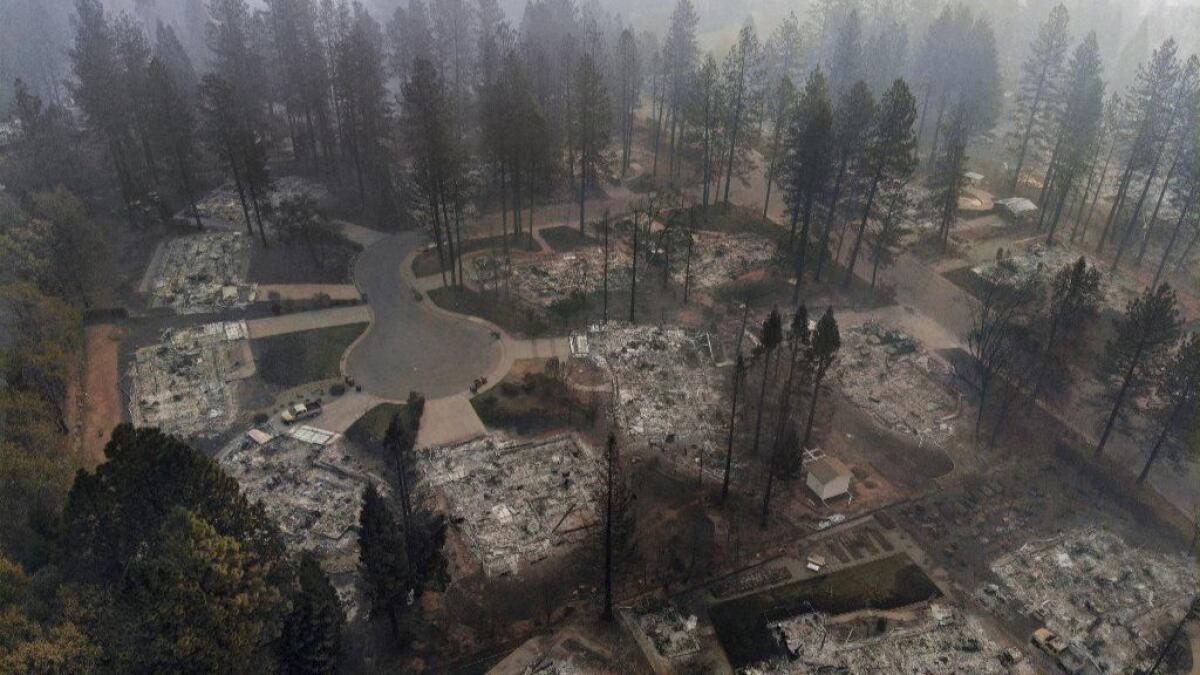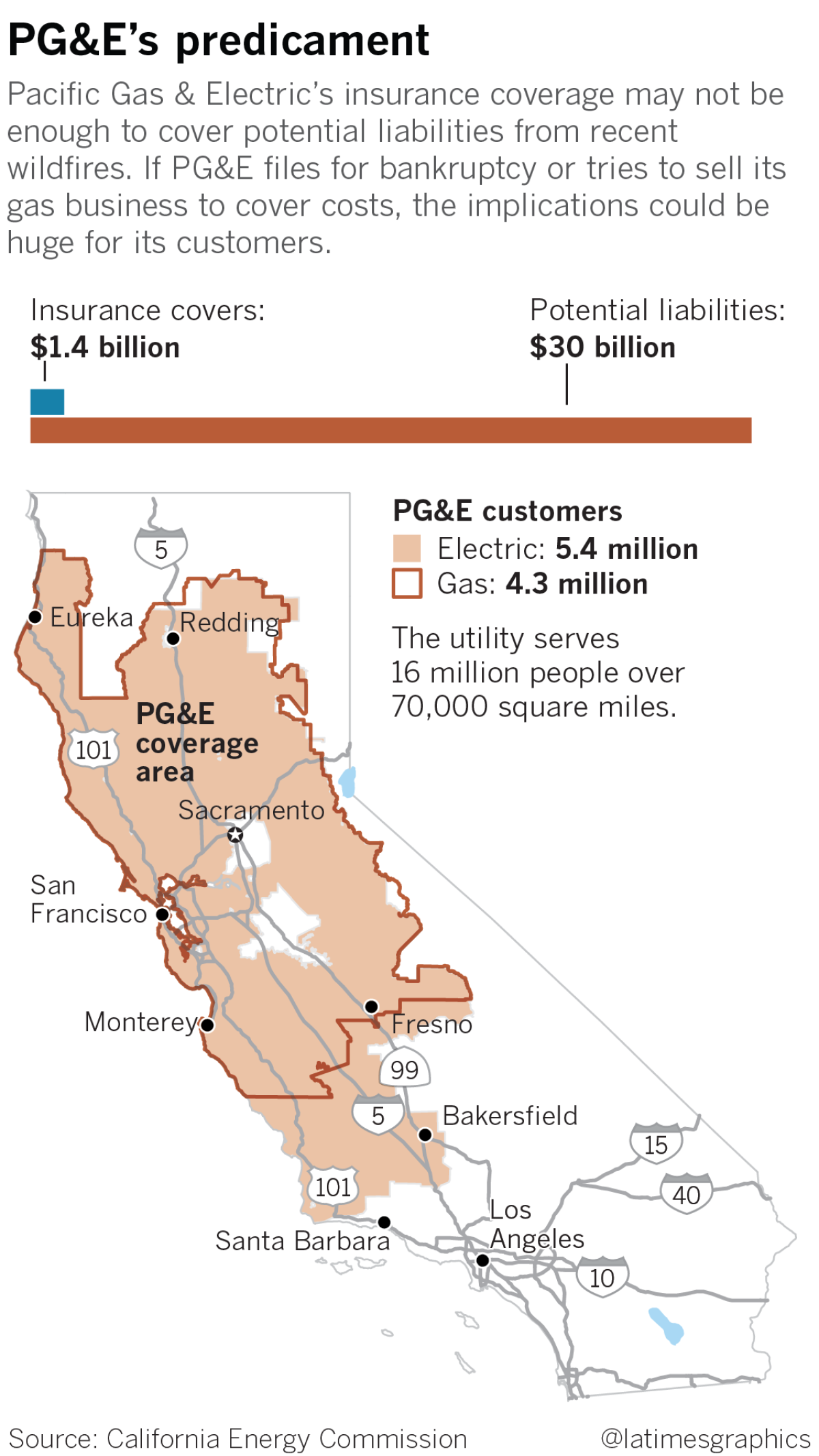What would happen if PG&E sold its gas business or filed for bankruptcy?

- Share via
California’s largest power company faces an existential crisis as it confronts the looming possibility of tens of billions of dollars in wildfire liability.
Shares of PG&E Corp. — which owns Pacific Gas & Electric Co. — sank 22.3% to $18.95 on Monday after reports that the utility could face at least $30 billion in liability related to fires and has considered filing for bankruptcy protection or unloading its natural gas operations.
For the record:
9:05 a.m. Jan. 8, 2019An earlier version of this story stated that PG&E has nearly 50 million miles of natural gas pipelines. It has nearly 50,000 miles of such pipelines.
UPDATE: Battered by wildfires and scandals, PG&E files for bankruptcy »
The consequences of bankruptcy or an asset sale could ripple far beyond the utility’s shareholders, some experts say, affecting 16 million Californians who depend on PG&E for energy and potentially threatening the state’s ability to meet its climate-change goals.
The utility has faced tremendous scrutiny over the last decade, starting with a 2010 gas explosion that killed eight people in San Bruno and continuing with among the deadliest and most destructive fires in state history, some of which may have been sparked by PG&E’s infrastructure. The California Public Utilities Commission is considering breaking up the company as part of an investigation into PG&E’s safety culture.
Some PG&E critics have called for a government takeover or for the massive company to be replaced by smaller, municipal utilities. But it’s far from clear that local governments across Northern and Central California have the ability or the desire to take control of PG&E’s infrastructure, and to assume the huge liabilities that running the power grid entails. And state officials aren’t likely to support a takeover because then the utility’s problems would become Sacramento’s problems instead.
“For the state to take over every bit of the wildfire liabilities is just insane,” said Mike Gatto, a former state lawmaker who led the Assembly’s utilities committee.
PG&E declined to comment on specific steps it may be considering. In an emailed statement, spokesman Andy Castagnola said the company is “reviewing structural options to best position PG&E to implement necessary changes.”
“Safety is and will continue to be our top priority as we work to determine the best path forward for all of our stakeholders. PG&E remains fully committed to helping our customers and the affected communities recover and rebuild — and to doing everything we can to reduce the risk of future wildfires,” Castagnola said.
The fundamental challenge is that PG&E isn’t like most private companies. It’s the only entity authorized to deliver electricity to 5.4 million homes and businesses, and gas for home heating and cooking to 4.3 million customers. The company’s geographic reach spans nearly half the state, from Eureka to Bakersfield.

The Public Utilities Commission is eager to avoid a Bankruptcy Court proceeding, in which a federal judge would control the company’s fate and the interests of creditors would be placed above those of ratepayers. Commission President Michael Picker has said California won’t let PG&E go bankrupt. He compared the process of reforming the troubled company to “repairing a jetliner while it’s in flight.”
“Crashing a plane to make it safer isn’t good for the passengers,” Picker said in a statement last month.
For one thing, a bankruptcy could lead to higher rates for PG&E customers.
The company filed for bankruptcy once before, in the midst of the early-2000s energy crisis that stemmed from a failed deregulation scheme and led to rolling power outages in much of the state.
The crisis made California a riskier place to invest, which led to higher borrowing costs for PG&E and the state’s second-largest investor-owned utility, Southern California Edison. Those costs were passed on to utility customers in the form of higher rates, said Michael Colvin, a former top official at the Public Utilities Commission.
“It probably took 5 to 10 years for California to shake that risk premium that happened after the energy crisis,” said Colvin, who now works as a senior manager for the Environmental Defense Fund, a nonprofit advocacy group.
Renewable energy developers, meanwhile, are worried a bankruptcy filing would make it more difficult for California to meet its environmental goals.
California law requires the state to get 60% of its electricity from climate-friendly sources by 2030 and 100% by 2045. Developers say meeting those targets depends on financially viable utility companies that can sign long-term contracts to buy electricity from solar and wind farms or from other clean energy facilities. Those long-term utility contracts allow developers to secure financing to get their projects built.
“We have tens of billions of dollars worth of contracts with PG&E to meet the state’s climate change goals and its renewable energy goals. A bankruptcy would be very disruptive, basically put those contracts potentially in danger, and would send potentially a very negative signal in terms of future development in California,” said Jan Smutny-Jones, chief executive of the Independent Energy Producers Assn., a trade group that represents renewable energy and natural gas developers.

Mark Toney, executive director of the Utility Reform Network, a ratepayer watchdog group, has a different worry. He’s afraid PG&E might play up the risk of bankruptcy as a scare tactic, to persuade state lawmakers to shield the company’s shareholders from huge potential liability from Northern California’s 2017 Tubbs fire, which killed 22 people, and the 2018 Camp fire, which killed 86 people.
He pointed to the Legislature’s approval last year of Senate Bill 901, which allows PG&E and other investor-owned utilities to charge ratepayers for some of the costs they may incur from 2017’s deadly fires.
“PG&E threatened bankruptcy last year and got their bailout. And they are threatening bankruptcy again and are asking for another bailout. That’s not sustainable,” Toney said.
Toney described bankruptcy as a “bad option” but still better than business as usual at California’s biggest utility. He said dramatic changes are needed to transform PG&E.
“There needs to be some sort of fundamental reorganization. Whether that will be accomplished through a new board of directors, new management, or someone else coming in to run the franchise, or the company being broken up into different components, we don’t know what the real proposals are out there,” Toney said.
A sale of PG&E’s gas business, the possibility of which was reported last week by National Public Radio, wouldn’t fix the utility’s safety problems. But it could help the company pay down billions of dollars in wildfire-related costs.
For now, it’s unclear how realistic such a sale would be. PG&E’s guaranteed customer base and its nearly 50,000 miles of natural gas pipelines would almost certainly attract potential buyers. But a sale would need to be approved by the Public Utilities Commission, which could require any buyer to take steps to protect ratepayers.
Another obstacle is organized labor, a politically powerful group that is already objecting to a potential sale. The International Brotherhood of Electrical Workers represents more than 12,000 PG&E employees, roughly 3,000 of whom work on the gas side of the business. Tom Dalzell, business manager for IBEW Local 1245, said a sale of PG&E’s gas assets would be “a long and complicated process with many opportunities for our members to lose something,” from retirement benefits to career options.
Ratepayer advocates would scrutinize a sale too. One key question: Would the buyer be a utility with a strong safety record or a hedge fund looking for a quick profit?
“We certainly don’t want to exchange one bad actor for another bad actor,” Toney said.
Another complicating factor: Selling natural gas in California is a business that may have a limited lifespan. The state has set a target of reducing greenhouse gas emissions 80% below 1990 levels by 2050. The burning of natural gas for electricity and heating accounts for a significant chunk of those planet-warming emissions.
More to Read
Inside the business of entertainment
The Wide Shot brings you news, analysis and insights on everything from streaming wars to production — and what it all means for the future.
You may occasionally receive promotional content from the Los Angeles Times.











